Orixa japonica
| Orixa japonica | ||||||||||||
|---|---|---|---|---|---|---|---|---|---|---|---|---|

Orixa japonica |
||||||||||||
| Systematics | ||||||||||||
|
||||||||||||
| Scientific name of the genus | ||||||||||||
| Orixa | ||||||||||||
| Thunb. | ||||||||||||
| Scientific name of the species | ||||||||||||
| Orixa japonica | ||||||||||||
| Thunb. |
Orixa japonica is a species ofthe rhombus family (Rutaceae). It is the only representative of the monotypical genus Orixa . Except for the Germanized word "Orixie", this species has no German name.
description
Growth habit and leaves
Orixa japonica is a deciduous shrub that can reach heights of up to 3 meters. The bark is grayish. The alternate, elliptical to inversely egg-shaped, entire, 5 to 12 cm long and 3 to 7 cm wide leaves are dark green on the top and slightly lighter on the underside. The petiole is 0.5 to 1 cm long. The leaves smell aromatic when rubbed. Orixa japonica shows a peculiar phyllotaxis , which is called the "Orixa type". The order of the leaves is as follows: small leaf on the left, large leaf on the left, small leaf on the right, large leaf on the right, etc., with the larger leaves rather emerging from the top of the horizontally growing shoots and the small leaves rather emerge at the bottom (Bell 1994). In autumn the leaves turn yellow.
Inflorescences and flowers
Orixa japonica is dioecious separate sexes ( diocesan ). The unisexual flowers develop in April to May , the females are solitary and the males in small racemose inflorescences . All flowers are greenish in color and four-fold. The four egg-shaped sepals are fused at the base. The four elliptical and roof-top arranged petals are only 3 mm long. In the male flowers there is only one circle with four stamens . In the female flowers the four carpels are free. The short styles are partly fused and end with four scar branches.
Flower formula : or
Fruits and seeds
The fruit, which is greenish in color when unripe and later turns brown, disintegrates into three or four 8 to 10 mm large partial fruits (split capsules) when ripe - in the Flora of China the fruit is described as one to four follicles that are only fused at the base . These each contain only one black, spherical seed, about 4 mm in size, which, similar to the diptam , are autochoric due to hygroscopic tensions .
Chromosome number
20 chromosomes are named in a diploid set, probably increased from the original 2n = 18 within the Rutaceae due to dysploidy (Stace et al. 1993).
distribution
This plant species is native to Japan , southern Korea and the Chinese provinces : Anhui , Fujian , Guizhou , southern Henan , Hubei , northwestern Hunan , Jiangsu , northern Jiangxi , southeastern Shaanxi , Sichuan , northwestern Yunnan , Zhejiang and occurs there in forests, Thickets and sunny slopes at altitudes between 500 and 1300 m.,
Systematics
The genus Orixa is monotypical . Synonyms for Orixa japonica Thunb. are Othera orixa (Thunb.) Lam. , Evodia ramiflora A. Gray , Celastrus orixa (Thunb.) Sieb. & Zucc. , Celastrus japonicus (Thunb.) K. Koch and Celastrus dilatatus Thunb.
ingredients
As in Ruta and Dictamnus , the furanocoumarins psoralen , bergapten and xanthotoxin also occur in Orixa , the concentration of which in the study by Zobel & Brown (1990) is the second highest after Ruta graveolens and ahead of Heracleum mantegazzianum .
literature
- Dianxiang Zhang , Thomas G. Hartley & David J. Mabberley: Rutaceae in der Flora of China , Volume 11, p. 66: Orixa japonica - Online.
- AD Bell: Illustrated Morphology of Flowering Plants , Ulmer Verlag Stuttgart, 1994, 335p.
- Robert Zander : Zander concise dictionary of plant names. Edited by Fritz Encke , Günther Buchheim, Siegmund Seybold . 14th, revised and expanded edition. Eugen Ulmer, Stuttgart 1993, ISBN 3-8001-5063-8 .
- J. Ohwi: Flora of Japan , Smithsonian Institution Washington DC, 1965, 1067p.
- HM Stace, JA Armstrong & SH James: Cytoevolutionary patterns in Rutaceae , Plant Systematics and Evolution 187, 1993 .: pp. 1-28.
- AM Zobel & SA Brown: Dermatitis-inducing Furanocoumarins on leaf surfaces of eight species of Rutaceous and Umbelliferous plants. Journal of Chemical Ecology, 1990, 16 (3): pp. 693-700.
Individual evidence
- ^ A b c J. Ohwi: Flora of Japan , Smithsonian Institution Washington DC, 1965. 1067p.
- ^ A b Dianxiang Zhang, Thomas G. Hartley & David J. Mabberley: Rutaceae in der Flora of China , Volume 11, p. 66: Orixa japonica - Online.
Web links
- Characteristics. (engl.)
- Entry in Plants for a Future. (engl.)






